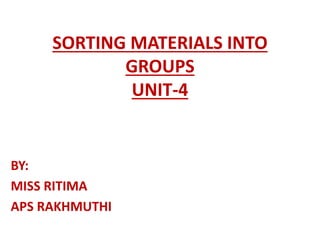
Sorting materail into groups
- 1. SORTING MATERIALS INTO GROUPS UNIT-4 BY: MISS RITIMA APS RAKHMUTHI
- 2. WHAT ARE THINGS MADE UP OF? When we look around, we find ourselves surrounded by a number of objects. These different objects are made from a number of different materials, while some are made using the same material. For Example, both desk and chair are made from wood while pen and dustbins are made using plastic. The material from which an object is made depends on its properties
- 3. OBJECT AND MATERIAL THEY ARE MADE OF
- 4. PROPERTIES OF MATERIAL There are two properties which are common to all materials, these properties are: All materials occupy space. All materials have mass.
- 5. MATERIALS THAT YOU USE IN DAILY LIFE
- 6. - In previous slide you see different materials , depending upon properties and use, we segregate them into different groups. Grouping together of things having similar properties is called classification. Some of the properties of materials which help us to classify are: Appearance Hardness Solubility - Soluble or insoluble Density – float or sink Transparency
- 7. APPEARANCE Materials look different from each other. Plastic look different for paper, paper looks different from wood , iron looks different from aluminium and so on. some materials have lusture (shine) . Examples - gold, copper, aluminium, iron etc. Materials on basis of lustre can usually be classified as Metals and Nonmetals. Metal loses its lustre after some time due to the action of moisture and air on it. Therefore only freshly-cut metals appear to have lustre on them.
- 8. .
- 9. HARDNESS Materials can also be classified on the basis of hardness. Materials that can be easily compressed or scratched are called Soft. Materials that cannot be scratched and are difficult to compress are termed as Hard.
- 10. Solubility Materials that can be dissolved in water upon stirring are said to be soluble materials. For Example: Sugar and Salt can be dissolved in water. Materials that cannot be dissolved in water (no matter how much we stir them) are said to be insoluble materials. For Example, Stones and Clothes cannot be dissolved in water.
- 11. DENSITY Density is mass per unit volume of the substance. Substances having higher density will sink and substances having lower density will float in water. For Example: leaves and corks float in water while rocks and coins sink in water.
- 13. TRANSPARECY Objects or material through which we can see are said to be transparent objects. For Example, Glass, clear water . Objects and materials through which things can be seen but only partially are called Translucent objects. Butter paper and frosted glass are some examples of translucent objects. Objects through which we can not see are known as opaque objects. For Example, Metals, wood and cardboard are some examples of opaque materials as you cannot see through them.
Editor's Notes
- Sorting material into groups
